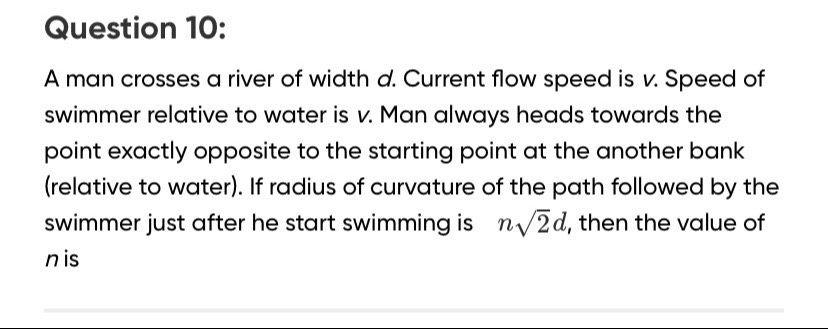Question
Question: A man crosses a river of width $d$. Current flow speed is $v$. Speed of swimmer relative to water is...
A man crosses a river of width d. Current flow speed is v. Speed of swimmer relative to water is v. Man always heads towards the point exactly opposite to the starting point at the another bank (relative to water). If radius of curvature of the path followed by the swimmer just after he start swimming is n2d, then the value of n is

2
Solution
Let the river flow along the positive x-axis with velocity vr=vi^. The width of the river is d along the y-axis. Let the starting point be the origin (0,0). The point exactly opposite to the starting point on the other bank is (0,d).
The swimmer's velocity relative to water, vsw, has a magnitude of v. The problem states that the swimmer "always heads towards the point exactly opposite to the starting point at the another bank (relative to water)". This means the direction of vsw is always towards the point (0,d) from the swimmer's current position (x,y). The vector from (x,y) to (0,d) is (0−x,d−y)=(−x,d−y). Thus, the velocity of the swimmer relative to water is: vsw=v(−x)2+(d−y)2(−x,d−y)=v(x2+(d−y)2−xi^+x2+(d−y)2d−yj^)
The velocity of the swimmer relative to the ground is vs=vsw+vr. vs=v(x2+(d−y)2−xi^+x2+(d−y)2d−yj^)+vi^ vs=v(1−x2+(d−y)2x)i^+vx2+(d−y)2d−yj^
Let vs=x˙i^+y˙j^. We have: x˙=dtdx=v(1−x2+(d−y)2x) y˙=dtdy=vx2+(d−y)2d−y
We need to find the radius of curvature of the path just after the swimmer starts, which is at t=0 when (x,y)=(0,0). At (x,y)=(0,0): Let A=x2+(d−y)2=02+(d−0)2=d. x˙(0,0)=v(1−d0)=v y˙(0,0)=vdd−0=v The speed at t=0 is v0=x˙2+y˙2=v2+v2=v2.
The radius of curvature R is given by the formula: R=∣x˙y¨−y˙x¨∣(x˙2+y˙2)3/2 We need to find the accelerations x¨ and y¨ at t=0. x¨=dtdx˙=∂x∂x˙x˙+∂y∂x˙y˙ y¨=dtdy˙=∂x∂y˙x˙+∂y∂y˙y˙
Let's calculate the partial derivatives at (x,y)=(0,0), where A=d, x˙=v, y˙=v: ∂x∂x˙=vA3−(d−y)2=vd3−d2=−dv ∂y∂x˙=vA3−x(d−y)=vd3−0⋅d=0 ∂x∂y˙=vA3−x(d−y)=vd3−0⋅d=0 ∂y∂y˙=vA3−x2=vd3−02=0
Now, calculate x¨ and y¨ at t=0: x¨(0,0)=(−dv)(v)+(0)(v)=−dv2 y¨(0,0)=(0)(v)+(0)(v)=0
Substitute these values into the radius of curvature formula: R=v⋅0−v⋅(−dv2)(v2+v2)3/2=dv3(2v2)3/2 R=v3/d(v2)3=v3/d22v3=22d
The problem states that the radius of curvature is n2d. Comparing this with our result: n2d=22d n=2
